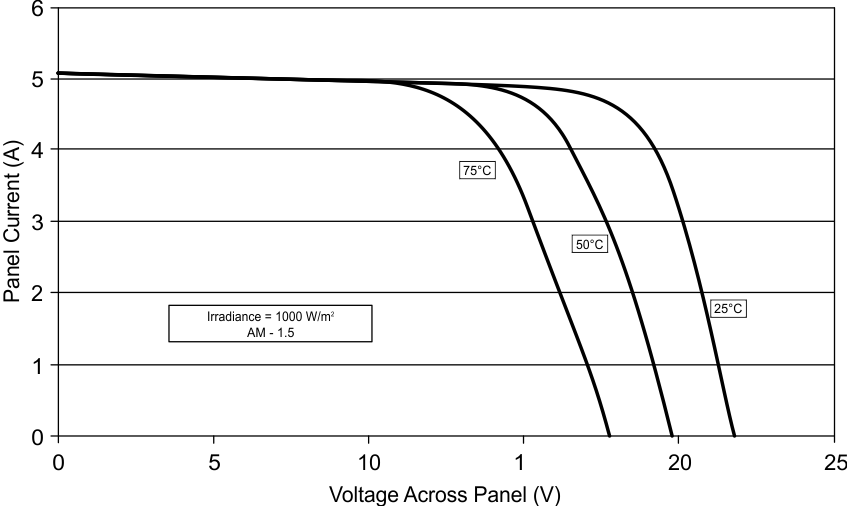TIDUEJ8C January 2019 – May 2024
- 1
- Description
- Resources
- Features
- Applications
- 6
- 1System Description
- 2System Overview
- 3Hardware, Software, Testing Requirements, and Test Results
- 4Design Files
- 5Related Documentation
- 6About the Author
- 7Revision History
2.4.1 MPPT Operation
The power output from a PV panel depends on a few parameters, such as the irradiation received by the panel, panel voltage, panel temperature, and so forth. The power output also varies continuously throughout the day as the conditions affecting the change.
Figure 2-7 shows the I-V curve and the P-V curve of a solar panel. The I-V curve represents the relationship between the panel output current and the output voltage. As the I-V curve in the figure shows, the panel current is at the maximum when the terminals are shorted and is at the lowest when the terminals are open and unloaded.
 Figure 2-7 Solar Panel Characteristics I-V and P-V Curves
Figure 2-7 Solar Panel Characteristics I-V and P-V Curves As Figure 2-7 shows, obtain the maximum power output from the panel represented as PMAX at a point when the product of the panel voltage and the panel current is at the maximum. This point is designated as the maximum power point (MPP).
The graphs in Figure 2-8 and Figure 2-9 show examples of how each of the various parameters affect the output power from the solar panel. The graphs also show the variation in the power output of a solar panel as a function of irradiance. Observe in these graphs how the power output from a solar panel increases with the increase in irradiance and decreases with a decrease in irradiance. Also note that the panel voltage at which the MPP occurs also shifts with the change in irradiance.
 Figure 2-8 Solar Panel Output Power Variation Under Different Irradiation Conditions—Graph A
Figure 2-8 Solar Panel Output Power Variation Under Different Irradiation Conditions—Graph A  Figure 2-9 Solar Panel Output Power Variation Under Different Irradiation Conditions—Graph B
Figure 2-9 Solar Panel Output Power Variation Under Different Irradiation Conditions—Graph B Figure 2-10 shows a typical graph representing the variation in the power output of a photovoltaic panel as a function of the temperature. Observe how the panel current (and thereby the panel power) decreases with an increase in temperature. The MPP voltage continues to shift substantially with the change in temperature.
 Figure 2-10 Solar Panel I-V Curve Variation With Temperature Under Constant Irradiation Conditions
Figure 2-10 Solar Panel I-V Curve Variation With Temperature Under Constant Irradiation Conditions Draw the maximum power from a solar panel by operating the panel close to the MPP point; however, doing so poses two challenges:
- Providing a way to connect a battery or load with a different operating voltage in comparison to the MPP of the panel
- Identifying the MPP automatically, as the MPP varies with the environmental conditions and is not a constant
Directly connecting a solar panel with a VMPP close to 17V to a 12V lead acid battery forces the panel to operate at 12V, which reduces the amount of power that can be drawn from the panel. From this situation, one can surmise that a DC/DC converter is able to draw more power from the solar panel because this converter forces the solar panel to operate close to the VMPP and transfer the power to a 12V lead acid battery (impedance matching).
The preceding paragraph explains why the user implements a synchronous buck converter to charge the lead acid battery from the solar panel and address the first challenge.
The second challenge of automatically identifying the MPP of the panel is typically performed by employing MPPT algorithms in the system. The MPPT algorithm tries to operate the photovoltaic panel at the maximum power point and uses a switching power stage to supply the load with the power extracted from the panel.
Perturb and observe is one of the most popular MPPT algorithms used. The fundamental principle behind this algorithm is simple and easy to implement in a microcontroller based system. The process involves slightly increasing or decreasing (perturbing) the operating voltage of a panel. Perturbing the panel voltage is accomplished by changing the duty cycle of the converter. Assuming that the panel voltage has been slightly increased and that this leads to an increase in the panel power, then another perturbation in the same direction is performed. If the increase in the panel voltage decreases the panel power, then a perturbation in the negative direction is done to slightly lower the panel voltage.
By performing the perturbations and observing the power output, the system begins to operate close to the MPP of the panel with slight oscillations around the MPP. The size of the perturbations determines how close the system is operating to the MPP. Occasionally this algorithm can become stuck in the local maxima instead of the global maxima, but this problem can be solved with minor tweaks to the algorithm.
The P&O algorithm is easy to implement and effective, and was chosen for this design.